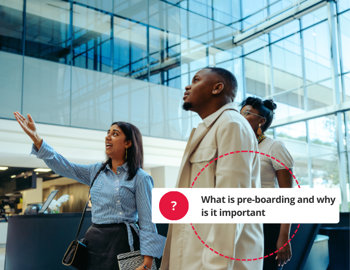
What is preboarding?
What does preboarding mean? Preboarding refers to the period between a new hire accepting an offer and their first day on the job. It involves activities and communications that help employees to familiarise themselves with the company, complete necessary paperwork, and feel welcomed before they officially start.
The main focus is to make the transition smoother for new hires. A well-planned process can significantly impact an employee's confidence and readiness for their new role. For the company, this leads to faster integration, higher engagement, and reduced turnover, improving productivity and retention while reinforcing a positive employer brand.
How is preboarding different from onboarding?
Onboarding is a longer process that begins when an employee officially starts their job. It includes in-depth training, integration into company culture, and setting performance expectations. The goal is to ensure that employees are fully equipped to succeed in their roles and contribute effectively to the business.
Preboarding employees, on the other hand, happens before their start date. The focus is on making them feel welcomed, providing essential company information, and handling administrative tasks efficiently. This gives them the confidence and preparedness to hit the ground running on their first day. If you’re looking to improve your employee onboarding experience, consider implementing or improving your process.
Why is preboarding employees important?
A well-structured preboarding process sets the tone for an employee’s journey with the company. It fosters engagement, reduces anxiety and ensures a smoother transition into their new role. Let’s take a look at why preboarding employees is essential.
Establishes a positive relationship
The way an employer engages with a new hire before their first day significantly impacts their overall employee experience. A thoughtful process makes employees feel valued and excited about joining the company, reducing any uncertainty they might have.
Supports the new hire
New employees often have questions and concerns before starting a new job. Preboarding helps to provide clarity, sets expectations and makes new hires feel valued. This supports the overall employee lifecycle by starting the relationship on a positive note.
Speeds up time to productivity
Employees who have completed paperwork, received company policies and know what to expect before their first day are more likely to become productive faster. This process eliminates unnecessary delays and helps to improve employee productivity from the outset.
Prevents employee turnover
Preboarding plays a crucial role in reducing staff turnover by helping to reassure employees that they made the right career choice. It builds loyalty and engagement early on, reducing the risk of them backing out before their start date or leaving soon after.
Step-by-step preboarding guide
An effective process ensures that new hires feel welcomed and prepared before their first day. We’ve put together a brief preboarding guide outlining the most important steps to ensure success.
1. Send the new hire a welcome email
A warm and informative welcome email helps new employees to feel valued before they even step into the workplace. It reassures them that they’ve made the right decision and provides useful details about their upcoming role.
In your email, include their start date, an introduction to the team, and any documents that they need to review. Encourage them to reach out if they have any questions, and consider adding a personal touch, such as a message from their future manager or team leader.
2. Complete all pre-employment paperwork
Handling paperwork before an employee’s start date helps to avoid unnecessary delays once they arrive. New hires should be able to complete employment contracts, tax forms and policy agreements in advance, freeing up more time in their first days and weeks for training and integration.
Using digital tools is a great way to streamline this part of the preboarding process, making it easy for employees to submit their documents. Automated workflows can also help HR teams to efficiently complete pre-employment checks to keep the recruitment process on track.
3. Plan the employee induction
A well-structured employee induction is important to ensure that new hires receive all the information they need to integrate smoothly into the team. To give employees the best possible start, and to create a positive impression of your company, it’s best to plan the induction in advance and apply it consistently.
Share an overview of the induction schedule, training sessions and key contacts with the new hire. This allows them to prepare ahead of time, gives them a better idea of what to expect, and helps to reduce those new job jitters.
4. Inform current team members of the new hire
Keeping existing employees informed about new hires helps to build a welcoming and inclusive environment. As well as preventing first-day awkwardness and encouraging team bonding, it helps to develop open communication within your organisation by keeping all employees in the loop.
As part of your process, make sure to send a company-wide email or announcement introducing the new hire, their role and their start date well in advance of their first day. If you’re planning to assign a mentor or implement a buddy system, don’t forget to include details of this in your email to existing employees.
5. Prepare the new hire’s workspace
Ensuring that a new employee’s workspace is ready before they arrive shows attention to detail and professionalism. It also helps them to settle in quickly and ensures that they have everything they need to start work.
Set up their desk, provide necessary equipment like computers, headsets and ergonomic chairs, and ensure that they have access to company systems and tools. Remember to also enrol them in employee self service for IT and HR requests so they can familiarise themselves with the system and be ready to use it from day one.
6. Give the new hire an opportunity to ask questions
New hires often have questions about company culture, policies and expectations that may leave them feeling uncertain. Providing them with an opportunity to ask questions before their start date gives them more confidence and better prepares them for their first day.
Your employee preboarding process might include scheduling a virtual meet-and-greet with the new hire’s direct manager, or sending a FAQ document covering common queries. Address topics such as working hours, benefits, and whether the company has a formal dress code to ensure clarity. Either way, make it clear to the new hire that they’re welcome to ask questions at any time.
Streamline employee preboarding with PeopleHR
Effective employee preboarding ensures that new hires feel welcome, prepared and engaged even before their first day. By implementing the right strategies, employers can improve staff retention, boost employee productivity and create a welcoming working environment, all of which offer great business benefits.
PeopleHR’s applicant tracking software simplifies this process by automating paperwork, scheduling inductions, and keeping employees informed at every step of the hiring process. To see how our platform can help your business, book a demo or contact us today.
